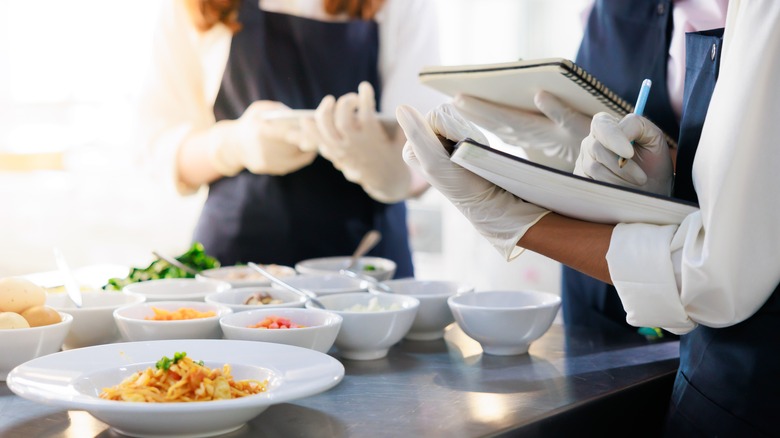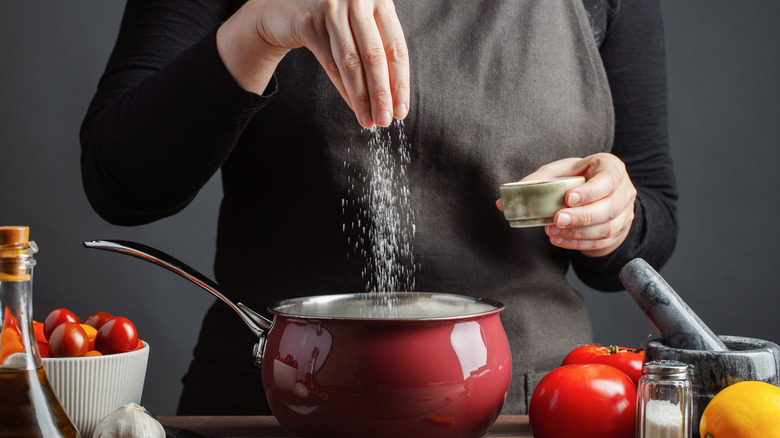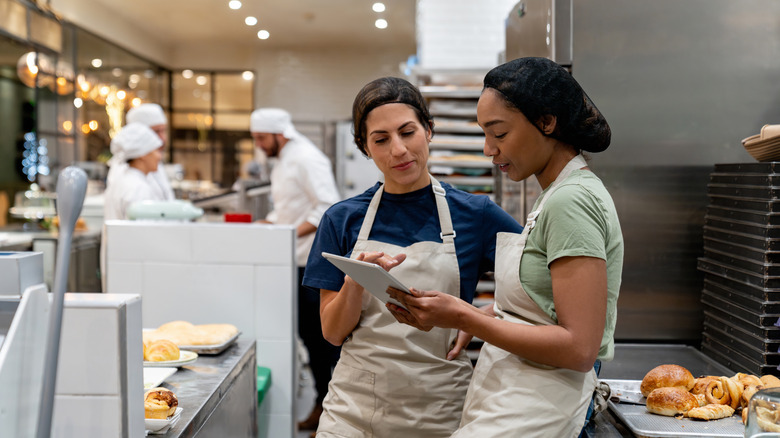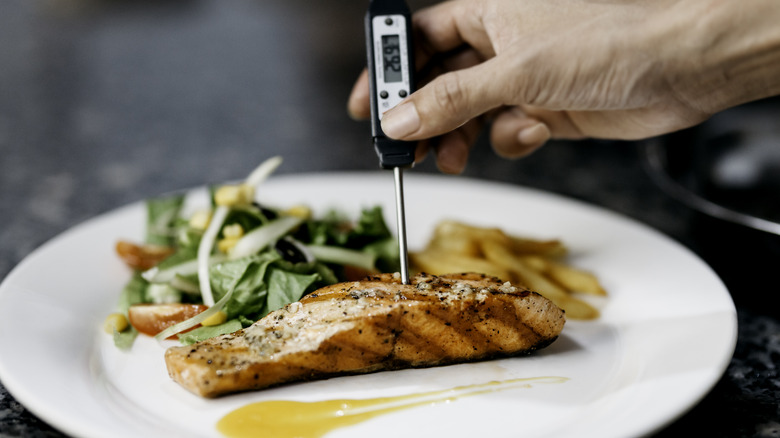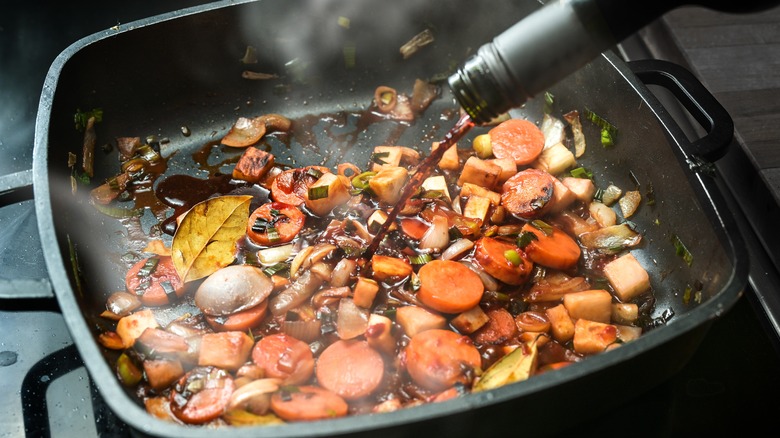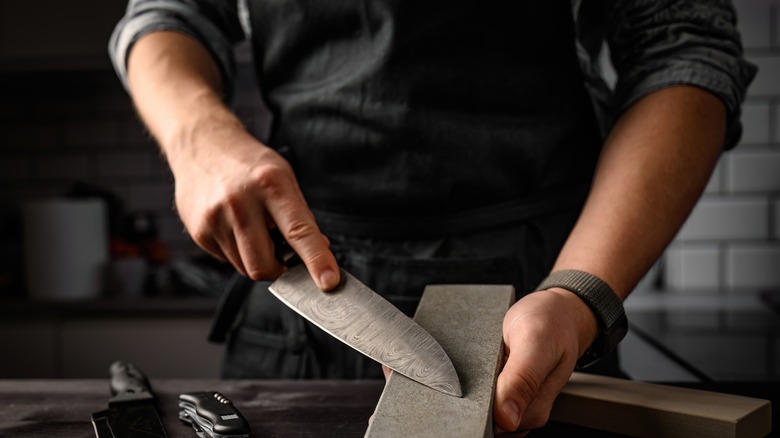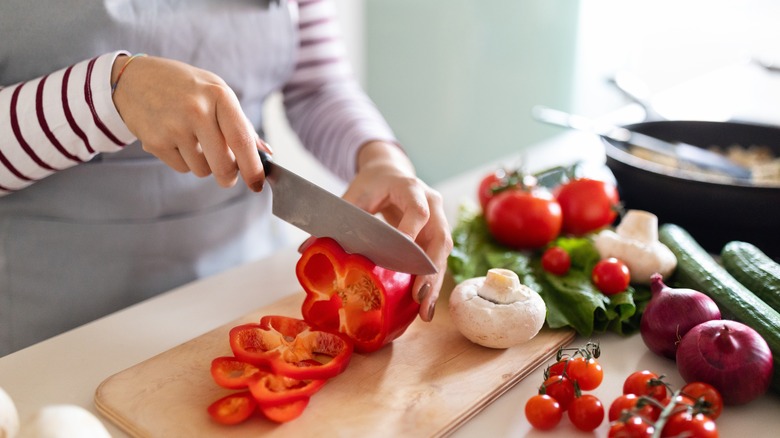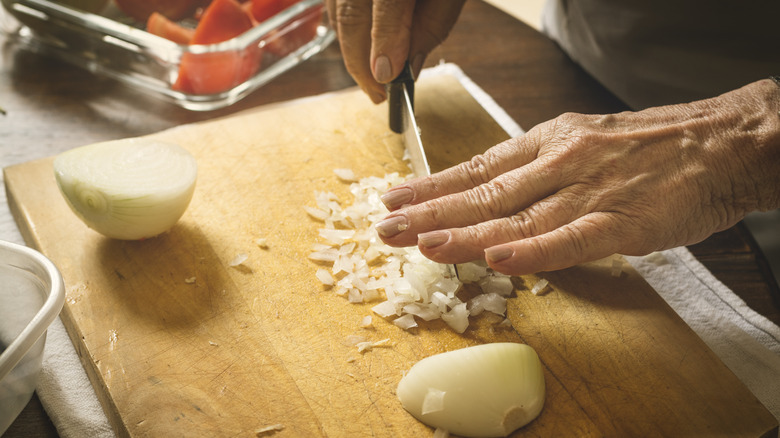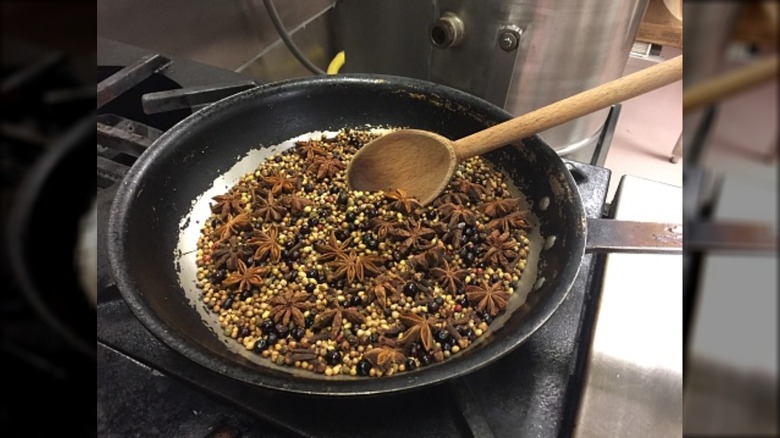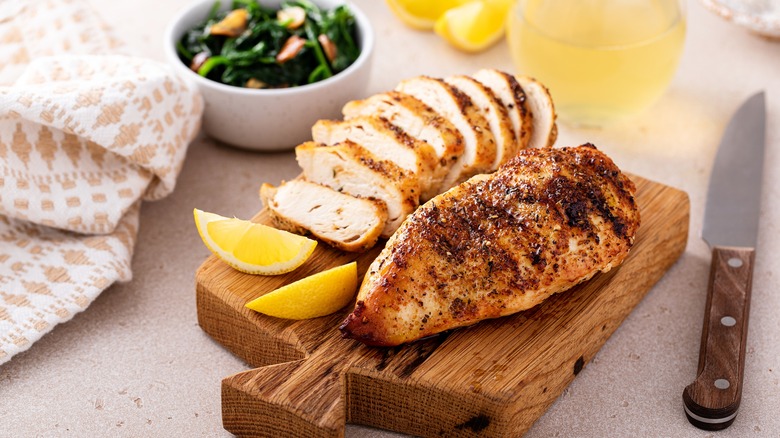The Best Kept Secrets That Chefs Learn In Culinary School
If you're a fan of the Food Network or cooking competition shows, you might assume that culinary school is where chefs learn to make extravagant, 5-star restaurant-worthy meals. That's true to an extent, but trained chefs first get a grasp of fundamental practices that take their cooking skills to the next level. Even the world's most awarded chef has to master these basic skills before achieving their more elaborate creations. That's why culinary school is a great program for aspiring cooks to learn the most essential secrets of the trade from working professionals.
While these culinary secrets are effective, many of them are not as complex as you might think, and you can easily implement them into your own cooking. Just because you aren't attending Le Cordon Bleu doesn't mean you can't learn critical culinary school tactics. By researching chef-approved methods and interviewing a culinary school graduate, we've unlocked some of the top culinary school secrets you can use to transform your recipes today.
Prepping makes all the difference
According to chefs, it's better to prep your ingredients ahead of time than to measure them as you go. This helps you to work more quickly and efficiently. It also means you don't have to worry about food burning on the stovetop while you're measuring the next ingredient. Amy Hand is a pastry chef and food writer at the Skillful Cook who studied at the Silwood School of Cookery. Speaking to Chowhound, she said that prep work was one of the most essential skills she learned in culinary school. "Even with a home-cooked meal, it's so important to get your ingredients ready before you start cooking. Having everything preweighed out means you can simply toss the ingredients in at the right point without having to interrupt your workflow with measuring," Hand explained. "You're also less likely to make mistakes when there's not a hot pot on the stove making you feel pressured."
This becomes even more important when working in a professional kitchen where there are lots of customers to feed, a tight timeline, and a standard expectation for every dish. Restaurant kitchens are a high-pressure environment, and for Hand, the secret she learned to deal with that stress is prep work. "Preparing your ingredients beforehand is key to a smooth workflow, and that is even more evident when cooking for large numbers," she said.
When you add seasoning matters
Bold herbs and spices are one of the best ways to add flavor to cooking. The perfect blend of seasonings can raise a simple dish to whole new flavor heights. Culinary students certainly learn how to work with spices to create a delicious and nuanced flavor profile. But they also learn that too much of a good thing can ruin a meal. Overseasoning is a common cooking mistake that professional chefs are taught to avoid. "Before cooking school, I was throwing salt into my saucy dishes at multiple points during the cooking process, which always ends in an overly salty final product," Amy Hand said. "Your dish will reduce throughout cooking and intensify the flavor. By waiting until the end, you will probably find yourself using much less salt, too."
When you should season your food depends on the type of dish that you're making. For example, most chefs recommend you add salt to pasta water while cooking to give the plain noodles a little bit more flavor. Similarly, many recipes call for salting meat before searing to help lock in moisture. But, as Hand pointed out, when preparing a saucy dish that will cook down, it's better to wait until the end. If you season it when you still have a lot of liquid in the pan, it will become much stronger and overly seasoned as the liquid cooks down.
Understanding individual ingredients changes everything
It's one thing to carefully follow a recipe and create a meal according to the instructions, but skilled chefs aren't just expected to recreate other people's recipes. They're also able to put their own spin on things and invent original dishes. Creating new recipes isn't just a matter of genius inspiration or guesswork. Although there may be some of that, chefs also have technical knowledge about how food works. They are able to create mouthwatering dishes by understanding the building blocks of cooking.
Apart from techniques, culinary students learn about the science of food, how ingredients interact, and how you can use that to make amazing dishes. Amy Hand said she struggled to get the results she wanted before culinary school because she didn't have a grasp of these fundamental concepts. "Once I got to cooking school, I learned the specific properties of flour and cornflour and how they react in very different ways. I think getting to know dishes at an ingredient level made a huge difference in how I approach cooking now," Hand said. Learning all these elements allows trained cooks to use the right ingredients to achieve the taste and texture they want.
Food safety is important
Along with learning how to make food appetizing, culinary students take courses on handling food safely to avoid foodborne illnesses and contamination. Food safety is paramount when prepping food professionally. Proper food storage, cooking temperatures, and clean tools all protect the health of consumers. Because of this, there are standards for cleanliness and food safety that are legally required for restaurants to stay in business, so it is essential that chefs learn these standards during training. "Food safety is fundamental to all areas of professional culinary arts," Lachlan Sands, President of the Institute of Culinary Education, explained during an interview with the school in 2023. "From a philosophical perspective, we are asking our guests to trust us with something very personal. We are asking them to place their faith in us that the food that they are about to consume is safe and healthful."
Food safety is taught to all culinary students, but Amy Hand said she wants more home cooks to have a thorough knowledge of the best practices for kitchen cleanliness and safety. "One of my pet peeves is seeing people let their pets walk all over their kitchen counters or dining tables," she said. "If they had been in our health and safety course at cooking school, they would be utterly disgusted and never let their cat on their counter ever again! I wish more people knew about this because I see it so often."
Deglaze pans
Trained chefs learn many techniques to create the most flavorful dishes possible. One of these methods is deglazing their pans when making sauces. Deglazing is an easy step to forget or skip, but it can make a huge difference in sauce recipes. This is the process of adding a splash of broth, wine, or some other kind of liquid to your pan after cooking. Once you've added the liquid, you can scrape any stuck-on food pieces off of the bottom of the pan and mix them into the deglazing liquid. It's a simple step that trained chefs learn to do, and you can easily implement it in your own cooking.
If you've ever wondered how restaurant sauces turn out so rich and savory, it's likely partially due to this key step. Amy Hand explained why deglazing is such a big game changer. "Deglazing a pan is essential for collecting all the delicious flavors left on the bottom of your pan. Once you've finished cooking your ingredients, there will be bits of caramelized food stuck to your pan, which is known as fond. There is so much flavor in fond that [it's] a waste not putting it to use," she said. "By deglazing your pan, you are lifting the tasty fond off the bottom of the pan and working it into your sauce to create a rich depth of flavor."
Take good care of your knives
Culinary school graduates know that great cooking isn't just about your ingredients. It's also about the quality of the tools you use, and learning to keep your knives in top shape is critical. All too often, we let our knives get dull or rusted, but trained cooks know that properly caring for knives makes them work better and last longer. "Chefs are always focused on having sharp knives because dull knives are a danger in the kitchen," chef and culinary instructor Frank Proto explained on an episode of Epicurious 101. "Dull knives take more pressure to cut with more of a chance you're going to slip and hurt yourself. A sharp knife gives you precision cuts that help your food cook evenly."
Trained chefs also know the best ways to sharpen knives. Proto advised against scraping two knives against each other. Although this is a common DIY technique, it won't give you the results you want. Instead, he recommends using a waterstone. A waterstone is a simple Japanese tool you wet in water before running a knife over the surface. The abrasive material of the stone wears down portions of the blade to sharpen it. Proto recommends sharpening your knives every few months for safe and accurate slicing.
The secret to fluffy cakes
Baking is a science, and a simple change in how you stir your ingredients can make the difference between a delightfully light and fluffy cake and a dense, overly chewy dessert. If you've ever struggled with your cake falling flat, not rising, or being too dense, this could be due to overmixing your batter. When stirring ingredients together, the temptation is to keep mixing until everything is perfectly consistent. But, with cake batters, this can be a mistake.
Overmixing batter is a common baking error that Amy Hand was often guilty of before going to culinary school. "I, like many home cooks, would always overmix my cake batter, which led to a heavy cake texture. At cooking school, they showed that you should fold together your ingredients with as little movement as possible to prevent overworking the gluten in the flour," Hand explained.
Overmixed batters and dough become dense, heavy, and gummy due to the excess gluten development. This is why many baking recipes will say to mix in dry and wet ingredients until "just combined." The term "just combined" means that you'll stop the mixing process as soon as the ingredients are blended, and be careful not to keep stirring or running your stand mixer longer than necessary. Keeping this in mind is a great way to get the texture of your baked goods closer to pastry chef quality.
Basic tools are the best ones
If you follow a lot of cooking accounts on social media, you likely get advertisements for plenty of specialized kitchen tools that claim they'll make cooking easier or somehow revolutionize your dishes. But Amy Hand said one of her main takeaways from culinary school was not to be taken in by these fancy products and to instead invest in a few reliable and multi-purpose kitchen tools. "The biggest lesson I learned is that basic kitchen tools will beat out the fancy one-use gadgets," Hand said. Whether you're a professional chef or an at-home cook, you don't need the latest invention as long as you have a few fundamental cooking and essential baking tools.
As far as what tools are necessary, Chef Julie Yoon said her must-have kitchen tools are an 8-inch chef's knife, paring knife, serrated knife, kitchen shears, honing rod, cutting board, measuring tools, digital thermometer, tongs, silicone spatula and wooden spoon, fish spatula, vegetable peeler, whisk, Microplane (fine grater), and colander. This list may seem very simple, but that's the beauty of it. Trained chefs know it's better to have a few reliable and versatile tools than to have your kitchen cluttered with too many single-use items.
The proper way to cut onions
While attending culinary school, chefs perfect techniques that they use in the kitchen all the time. Learning how to properly and quickly slice an onion is one of those techniques. Because onions are an aromatic ingredient used as a flavor component in so many of your favorite dishes, slicing them correctly can make a big difference in your cooking process. Trained chefs learn to slice vegetables accurately to get similarly-sized pieces. The even size allows for regular cooking and a consistent result. Proper technique also allows them to work quickly, which is essential in a professional kitchen setting.
If you want to master this skill and chop onions like a chef at home, Frank Proto recommended a few methods while hosting Epicurious 101. For onion rings, salads, fajitas, and other dishes where you want larger bites of onions, you can slice the root off the onion with a paring knife, peel, and then slice the onion into rings or halves using a chef knife. To dice onions, cut the onion in half through the root. Then, lay the onion half flat on the cutting board and make thin slices up to the root without cutting through the root. After creating these slices, it's easy to turn the vegetable and rock your knife back and forth as you cut in the opposite direction to create the finely diced pieces. You can also follow Anthony Bourdain's advice to slice onions safely.
Why you should toast spices
Toasting your spices is an incredible way to enhance the spice flavor and make it more effective. While it's not necessary for every meal, chefs know that when it comes to curries and similar dishes, toasting spices is one of the best ways to turn up the mouthwatering taste. Cooking instructor Chef Ali Hassan said toasting spices is one of the most consistent tips that he gives to his culinary students when they want to know why their recipes don't taste the same as his, even when they use the same spices. "I roast my spices almost religiously, and it takes the flavor to a new height and a new level of intensity that you don't see in the average spice off the shelf in a store," Hassan said on Bland is Boring.
To toast spices yourself, Hassan instructs putting a pan on medium-low heat and adding whole spices like coriander, peppercorn, and cumin seeds to the pan. As you roast the spices, gradually raise the heat. Be sure to pay close attention during this process. The spices will cook quickly to become more aromatic and bold. Remove from heat to stop toasting before the spices burn and ruin all that amazing flavor. Learn how to properly store spices for another way to boost the flavor.
Acid can take your dish to the next level
Celebrity chef Samin Nosrat became well-known for her cookbook and Netflix show "Salt Fat Acid Heat," which dives into the four core elements that create the flavors we love in the food we eat. Nosrat, as well as other chefs, learn the significance of these elements and how to use them for the most scrumptious results possible.
Even if you're just starting out cooking, you likely have a basic understanding of most of these components. Salt is a common ingredient in many dishes, and even if you don't cook, you've likely seen its effectiveness when adding a bit of table salt to a cooked dish. Similarly, we're all aware of how butter and other cooking oils can enrich a dish with the fat element. And heat is required to cook anything. But acid is a component that is all too often overlooked and has a big impact. "[Acid] brings balance and contrast. So there's a lot of secret sours of acid in our cooking that we don't think about," Nosrat explained to ABC News. "Sneaking them into food creates the contrast." Trained chefs know how to incorporate acid to make their recipes come alive.
